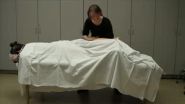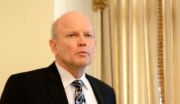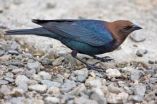(Press-News.org) One strategy for addressing the world's energy crisis is to stop wasting so much energy when producing and using it, which can happen in coal-fired power plants or transportation. Nearly two-thirds of energy input is lost as waste heat.
Now Northwestern University scientists have discovered a surprising material that is the best in the world at converting waste heat to useful electricity. This outstanding property could be exploited in solid-state thermoelectric devices in a variety of industries, with potentially enormous energy savings.
An interdisciplinary team led by inorganic chemist Mercouri G. Kanatzidis found the crystal form of the chemical compound tin selenide conducts heat so poorly through its lattice structure that it is the most efficient thermoelectric material known. Unlike most thermoelectric materials, tin selenide has a simple structure, much like that of an accordion, which provides the key to its exceptional properties.
The efficiency of waste heat conversion in thermoelectrics is reflected by its figure of merit, called ZT. Tin selenide exhibits a ZT of 2.6, the highest reported to date at around 650 degrees Celsius. The material's extremely low thermal conductivity boosts the ZT to this high level, while still retaining good electrical conductivity.
The ZT metric represents a ratio of electrical conductivity and thermoelectric power in the numerator (which needs to be high) and thermal conductivity in the denominator (which needs to be low).
Potential areas of application for the high-temperature thermoelectric material include the automobile industry (a significant amount of gasoline's potential energy goes out of a vehicle's tailpipe), heavy manufacturing industries (such as glass and brick making, refineries, coal- and gas-fired power plants) and places where large combustion engines operate continuously (such as in large ships and tankers).
"A good thermoelectric material is a business proposition -- as much commercial as it is scientific," said Vinayak P. Dravid, a senior researcher on the team. "You don't have to convert much of the world's wasted energy into useful energy to make a material very exciting. We need a portfolio of solutions to the energy problem, and thermoelectric materials can play an important role."
Dravid is the Abraham Harris Professor of Materials Science and Engineering at the McCormick School of Engineering and Applied Science.
Details of tin selenide, probably among the world's least thermally conductive crystalline materials, are published today (April 17) by the journal Nature.
The discovery comes less than two years after the same research group broke the world record with another thermoelectric material they developed in the lab with a ZT of 2.2.
"The inefficiency of current thermoelectric materials has limited their commercial use," said Kanatzidis, the Charles E. and Emma H. Morrison Professor of Chemistry in the Weinberg College of Arts and Sciences. "We expect a tin selenide system implemented in thermoelectric devices to be more efficient than other systems in converting waste heat to useful electricity."
The material, despite having a very simple structure, conducts heat so poorly that even moderate thermoelectric power and electrical conductivity are enough to provide high thermoelectric performance at high temperature.
The researchers did not expect to find tin selenide to be such a good thermoelectric material.
"Lidong Zhao, the first author of the paper, deserves a lot of credit for looking at tin selenide," said Kanatzidis, who also holds a joint appointment at Argonne National Laboratory. "He is a good example of the curious people we try to attract to Northwestern."
Zhao, a postdoctoral fellow in Kanatzidis' research group, grew crystals of tin selenide and measured the crystal in three directions, along each axis. He found that the thermal conductivity was "ridiculously low" along the a-axis but also along the other two axes.
"The results are eye-opening because they point in a direction others would not look," Dravid said. "This material has the potential to be applied to other areas, such as thermal barrier coatings."
Kanatzidis and Zhao identified the potential of the material intuitively by looking at its crystal structure. They confirmed its exceptional thermoelectric properties and then turned to Dravid and Christopher M. Wolverton to uncover how the crystal was behaving and why.
"We found that the bonds between some atoms in this compound are very weak and lead to exceptionally soft, floppy atomic vibrations," said Wolverton, a senior author of the paper and a professor of materials science at the McCormick School.
Wolverton, an expert in computational materials science related to energy applications, showed that the accordion-like structure and weak bonds lead to atoms that vibrate very slowly.
"These very weak vibrations are responsible for the inability of the material to conduct heat," Wolverton said. "Our theory provides the scientific basis as to why the material behaves the way it does and also provides us with a new direction to search for even higher-efficiency materials."
"Tin selenide reminds us of that popular TV commercial for a memory foam mattress in which a person can jump on one side of the mattress while a glass of wine a few feet away is unperturbed -- the vibrations do not reach the glass because of the mattress' material," Kanatzidis said.
"Similarly, in tin selenide, heat cannot travel well through this material because its soft, accordion-like structure doesn't transmit vibrations well," he said. "One side of tin selenide gets hot -- where the waste heat is, for example -- while the other side remains cool. This enables the hot side to generate useful electricity."
"Our discovery underscores why the Department of Energy EFRC program works," Kanatzidis said. "A multidisciplinary team, such as ours, can look at a problem from many different angles, with sustained funding increasing the chances of a scientific breakthrough. And we have a special ambience here -- the spirit of Northwestern is interdisciplinary."
INFORMATION:
The paper is titled "Ultralow thermal conductivity and high thermoelectric figure of merit in SnSe crystals." In addition to Kanatzidis, Dravid, Wolverton and Zhou, other authors of the paper are Yongsheng Zhang and Gangjian Tan, of Northwestern, and Hui Sun and Ctirad Uher, of the University of Michigan.
Surprising material could play role in saving energy
Researchers discover tin selenide is best at converting waste heat to electricity
2014-04-17
ELSE PRESS RELEASES FROM THIS DATE:
How vision makes sure that little fish do not get carried away
2014-04-17
This news release is available in German. Our eyes not only enable us to recognise objects; they also provide us with a continuous stream of information about our own movements. Whether we run, turn around, fall or sit still in a car – the world glides by us and leaves a characteristic motion trace on our retinas. Seemingly without effort, our brain calculates self-motion from this "optic flow". This way, we can maintain a stable position and a steady gaze during our own movements. Together with biologists from the University of Freiburg, scientists from the Max Planck ...
Massage therapy improves circulation, eases muscle soreness
2014-04-17
VIDEO:
Massage therapy improves general blood flow and alleviates muscle soreness after exercise, according to a study by researchers at the University of Illinois at Chicago.
Click here for more information.
Massage therapy improves general blood flow and alleviates muscle soreness after exercise, according to a study by researchers at the University of Illinois at Chicago.
The study, reported online in advance of print in the Archives of Physical Medicine and Rehabilitation, ...
Food shortages could be most critical world issue by mid-century
2014-04-17
WASHINGTON, D.C. -- The world is less than 40 years away from a food shortage that will have serious implications for people and governments, according to a top scientist at the U.S. Agency for International Development.
"For the first time in human history, food production will be limited on a global scale by the availability of land, water and energy," said Dr. Fred Davies, senior science advisor for the agency's bureau of food security. "Food issues could become as politically destabilizing by 2050 as energy issues are today."
Davies, who also is a Texas A&M AgriLife ...
Internet use may cut retirees' depression
2014-04-17
Spending time online has the potential to ward off depression among retirees, particularly among those who live alone, according to research published online in The Journals of Gerontology, Series B: Psychological Sciences and Social Sciences. In the article "Internet Use and Depression Among Retired Older Adults in the United States: A Longitudinal Analysis," the authors report that Internet use reduced the probability of a depressed state by 33 percent among their study sample.
Late-life depression affects between 5 and 10 million Americans age 50 and older. This new ...
A cross-section of the universe
2014-04-17
An image of a galaxy cluster taken by the NASA/ESA Hubble Space Telescope gives a remarkable cross-section of the Universe, showing objects at different distances and stages in cosmic history. They range from cosmic near neighbours to objects seen in the early years of the Universe. The 14-hour exposure shows objects around a billion times fainter than can be seen with the naked eye.
This new Hubble image showcases a remarkable variety of objects at different distances from us, extending back over halfway to the edge of the observable Universe. The galaxies in this image ...
Researcher looks at public perceptions around newborn testing
2014-04-17
TORONTO, April 17, 2014—While 94 per cent of Canadians surveyed said they would participate in public health programs that screen newborns for a specific number of genetic conditions, only 80 per cent said they would be willing to participate in screening that would sequence their newborns' genomes.
Most newborns in North America have a "heel prick test" in their first day or two of life in which a tiny amount of blood is taken from their heels and tested for about five to 54 conditions, depending on the state or province. Some conditions commonly tested for include cystic ...
Adrenaline does little to increase patient's survival after cardiac arrest
2014-04-17
TORONTO, April 17, 2014— Giving patients adrenaline after they suffer a cardiac arrest outside of a hospital does not increase their prospects of surviving long-term, according to new research conducted at St. Michael's Hospital.
"The vast number of patients who have a cardiac arrest get adrenaline, which has been the drug recommended in treating cardiac arrest for decades," said Dr. Steve Lin, an emergency physician and trauma team leader at St. Michael's. "Yet, despite advances in medical treatment, long-term survival rates of patients who suffer a cardiac outside a ...
Animal study provides first evidence that gel can prevent multiple virus transmission in vagina/rectum
2014-04-17
NEW YORK (17 April 2014)— Population Council scientists and their partners have found that their proprietary microbicide gel is safe, stable, and can prevent the transmission of multiple sexually transmitted infections (STIs) in both the vagina and rectum in animals: HIV, herpes simplex virus 2 (HSV-2), and human papillomavirus (HPV). The USAID-funded study also provides the first data that the gel is effective against multiple strains of HIV, and has a window of efficacy in the vagina against all three viruses of at least eight hours prior to exposure. A Phase 1 safety ...
Wireless power transfer achieved at 5-meter distance
2014-04-17
Daejeon, Republic of Korea, April 17, 2014 – The way electronic devices receive their power has changed tremendously over the past few decades, from wired to non-wired. Users today enjoy all kinds of wireless electronic gadgets including cell phones, mobile displays, tablet PCs, and even batteries. The Internet has also shifted from wired to wireless. Now, researchers and engineers are trying to remove the last remaining wires altogether by developing wireless power transfer technology.
Chun T. Rim, a professor of Nuclear & Quantum Engineering at KAIST, and his team ...
Fear of the cuckoo mafia
2014-04-17
This news release is available in German. If a restaurant owner fails to pay the protection money demanded of him, he can expect his premises to be trashed. Warnings like these are seldom required, however, as fear of the consequences is enough to make restaurant owners pay up. Similarly, mafia-like behaviour is observed in parasitic birds, which lay their eggs in other birds' nests. If the host birds throw the cuckoo's egg out, the brood parasites take their revenge by destroying the entire nest. Consequently, it is beneficial for hosts to be capable of learning and ...
LAST 30 PRESS RELEASES:
Numbers in our sights affect how we perceive space
SIMJ announces global collaborative book project in commemoration of its 75th anniversary
Air pollution exposure and birth weight
Obstructive sleep apnea risk and mental health conditions among older adults
How talking slows eye movements behind the wheel
The Ceramic Society of Japan’s Oxoate Ceramics Research Association launches new international book project
Heart-brain connection: international study reveals the role of the vagus nerve in keeping the heart young
Researchers identify Rb1 as a predictive biomarker for a new therapeutic strategy in some breast cancers
Survey reveals ethical gaps slowing AI adoption in pediatric surgery
Stimulant ADHD medications work differently than thought
AI overestimates how smart people are, according to HSE economists
HSE researchers create genome-wide map of quadruplexes
Scientists boost cell "powerhouses" to burn more calories
Automatic label checking: The missing step in making reliable medical AI
Low daily alcohol intake linked to 50% heightened mouth cancer risk in India
American Meteorological Society announces Rick Spinrad as 2026 President-Elect
Biomass-based carbon capture spotlighted in newly released global climate webinar recording
Illuminating invisible nano pollutants: advanced bioimaging tracks the full journey of emerging nanoscale contaminants in living systems
How does age affect recovery from spinal cord injury?
Novel AI tool offers prognosis for patients with head and neck cancer
Fathers’ microplastic exposure tied to their children’s metabolic problems
Research validates laboratory model for studying high-grade serous ovarian cancer
SIR 2026 delivers transformative breakthroughs in minimally invasive medicine to improve patient care
Stem Cell Reports most downloaded papers of 2025 highlight the breadth and impact of stem cell research
Oxford-led study estimates NHS spends around 3% of its primary and secondary care budget on the health impacts of heat and cold in England
A researcher’s long quest leads to a smart composite breakthrough
Urban wild bees act as “microbial sensors” of city health.
New study finds where you live affects recovery after a hip fracture
Forecasting the impact of fully automated vehicle adoption on US road traffic injuries
Alcohol-related hospitalizations from 2016 to 2022
[Press-News.org] Surprising material could play role in saving energyResearchers discover tin selenide is best at converting waste heat to electricity







